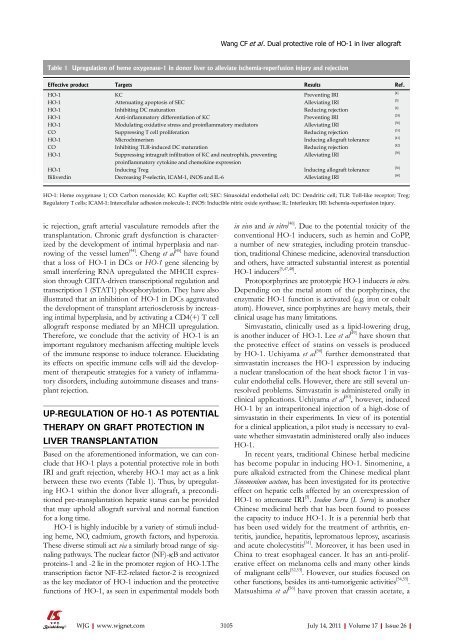26 - World Journal of Gastroenterology
26 - World Journal of Gastroenterology
26 - World Journal of Gastroenterology
You also want an ePaper? Increase the reach of your titles
YUMPU automatically turns print PDFs into web optimized ePapers that Google loves.
Table 1 Upregulation <strong>of</strong> heme oxygenase-1 in donor liver to alleviate ischemia-reperfusion injury and rejection<br />
Effective product Targets Results Ref.<br />
HO-1 KC Preventing IRI<br />
HO-1 Attenuating apoptosis <strong>of</strong> SEC Alleviating IRI<br />
HO-1 Inhibiting DC maturation Reducing rejection<br />
HO-1 Anti-inflammatory differentiation <strong>of</strong> KC Preventing IRI<br />
HO-1 Modulating oxidative stress and proinflammatory mediators Alleviating IRI<br />
CO Suppressing T cell proliferation Reducing rejection<br />
HO-1 Microchimerism Inducing allograft tolerance<br />
CO Inhibiting TLR-induced DC maturation Reducing rejection<br />
HO-1 Suppressing intragraft infiltration <strong>of</strong> KC and neutrophils, preventing<br />
proinflammatory cytokine and chemokine expression<br />
Alleviating IRI<br />
HO-1 Inducing Treg Inducing allograft tolerance<br />
Biliverdin Decreasing P-selectin, ICAM-1, iNOS and IL-6 Alleviating IRI<br />
ic rejection, graft arterial vasculature remodels after the<br />
transplantation. Chronic graft dysfunction is characterized<br />
by the development <strong>of</strong> intimal hyperplasia and narrowing<br />
<strong>of</strong> the vessel lumen [44] . Cheng et al [45] have found<br />
that a loss <strong>of</strong> HO-1 in DCs or HO-1 gene silencing by<br />
small interfering RNA upregulated the MHCII expression<br />
through CIITA-driven transcriptional regulation and<br />
transcription 1 (STAT1) phosphorylation. They have also<br />
illustrated that an inhibition <strong>of</strong> HO-1 in DCs aggravated<br />
the development <strong>of</strong> transplant arteriosclerosis by increasing<br />
intimal hyperplasia, and by activating a CD4(+) T cell<br />
allograft response mediated by an MHCII upregulation.<br />
Therefore, we conclude that the activity <strong>of</strong> HO-1 is an<br />
important regulatory mechanism affecting multiple levels<br />
<strong>of</strong> the immune response to induce tolerance. Elucidating<br />
its effects on specific immune cells will aid the development<br />
<strong>of</strong> therapeutic strategies for a variety <strong>of</strong> inflammatory<br />
disorders, including autoimmune diseases and transplant<br />
rejection.<br />
UP-REGULATION OF HO-1 AS POTENTIAL<br />
THERAPY ON GRAFT PROTECTION IN<br />
LIVER TRANSPLANTATION<br />
Based on the aforementioned information, we can conclude<br />
that HO-1 plays a potential protective role in both<br />
IRI and graft rejection, whereby HO-1 may act as a link<br />
between these two events (Table 1). Thus, by upregulating<br />
HO-1 within the donor liver allograft, a preconditioned<br />
pre-transplantation hepatic status can be provided<br />
that may uphold allograft survival and normal function<br />
for a long time.<br />
HO-1 is highly inducible by a variety <strong>of</strong> stimuli including<br />
heme, NO, cadmium, growth factors, and hyperoxia.<br />
These diverse stimuli act via a similarly broad range <strong>of</strong> signaling<br />
pathways. The nuclear factor (NF)-κB and activator<br />
proteins-1 and -2 lie in the promoter region <strong>of</strong> HO-1.The<br />
transcription factor NF-E2-related factor-2 is recognized<br />
as the key mediator <strong>of</strong> HO-1 induction and the protective<br />
functions <strong>of</strong> HO-1, as seen in experimental models both<br />
WJG|www.wjgnet.com<br />
Wang CF et al . Dual protective role <strong>of</strong> HO-1 in liver allograft<br />
HO-1: Heme oxygenase 1; CO: Carbon monoxide; KC: Kupffer cell; SEC: Sinusoidal endothelial cell; DC: Dendritic cell; TLR: Toll-like receptor; Treg:<br />
Regulatory T cells; ICAM-1: Intercellular adhesion molecule-1; iNOS: Inducible nitric oxide synthase; IL: Interleukin; IRI: Ischemia-reperfusion injury.<br />
in vivo and in vitro [46] . Due to the potential toxicity <strong>of</strong> the<br />
conventional HO-1 inducers, such as hemin and CoPP,<br />
a number <strong>of</strong> new strategies, including protein transduction,<br />
traditional Chinese medicine, adenoviral transduction<br />
and others, have attracted substantial interest as potential<br />
HO-1 inducers [5,47,48] .<br />
Protoporphyrines are prototypic HO-1 inducers in vitro.<br />
Depending on the metal atom <strong>of</strong> the porphyrines, the<br />
enzymatic HO-1 function is activated (e.g. iron or cobalt<br />
atom). However, since porphyrines are heavy metals, their<br />
clinical usage has many limitations.<br />
Simvastatin, clinically used as a lipid-lowering drug,<br />
is another inducer <strong>of</strong> HO-1. Lee et al [49] have shown that<br />
the protective effect <strong>of</strong> statins on vessels is produced<br />
by HO-1. Uchiyama et al [50] further demonstrated that<br />
simvastatin increases the HO-1 expression by inducing<br />
a nuclear translocation <strong>of</strong> the heat shock factor 1 in vascular<br />
endothelial cells. However, there are still several unresolved<br />
problems. Simvastatin is administered orally in<br />
clinical applications. Uchiyama et al [50] , however, induced<br />
HO-1 by an intraperitoneal injection <strong>of</strong> a high-dose <strong>of</strong><br />
simvastatin in their experiments. In view <strong>of</strong> its potential<br />
for a clinical application, a pilot study is necessary to evaluate<br />
whether simvastatin administered orally also induces<br />
HO-1.<br />
In recent years, traditional Chinese herbal medicine<br />
has become popular in inducing HO-1. Sinomenine, a<br />
pure alkaloid extracted from the Chinese medical plant<br />
Sinomenium acutum, has been investigated for its protective<br />
effect on hepatic cells affected by an overexpression <strong>of</strong><br />
HO-1 to attenuate IRI [5] . Isodon Serra (I. Serra) is another<br />
Chinese medicinal herb that has been found to possess<br />
the capacity to induce HO-1. It is a perennial herb that<br />
has been used widely for the treatment <strong>of</strong> arthritis, enteritis,<br />
jaundice, hepatitis, lepromatous leprosy, ascariasis<br />
and acute cholecystitis [51] . Moreover, it has been used in<br />
China to treat esophageal cancer. It has an anti-proliferative<br />
effect on melanoma cells and many other kinds<br />
<strong>of</strong> malignant cells [52,53] . However, our studies focused on<br />
other functions, besides its anti-tumorigenic activities [54,55] .<br />
Matsushima et al [56] have proven that crassin acetate, a<br />
3105 July 14, 2011|Volume 17|Issue <strong>26</strong>|<br />
[4]<br />
[5]<br />
[6]<br />
[24]<br />
[30]<br />
[31]<br />
[41]<br />
[42]<br />
[50]<br />
[56]<br />
[60]

















